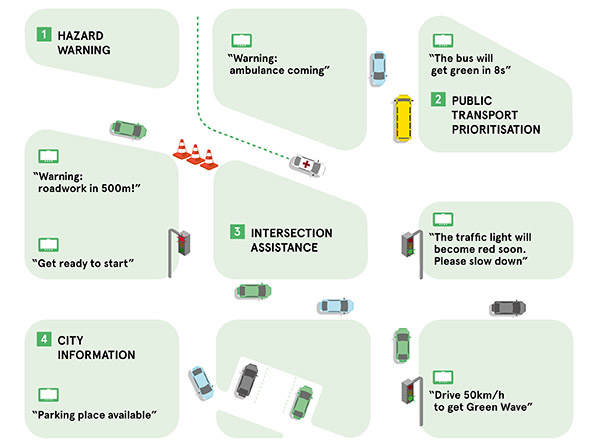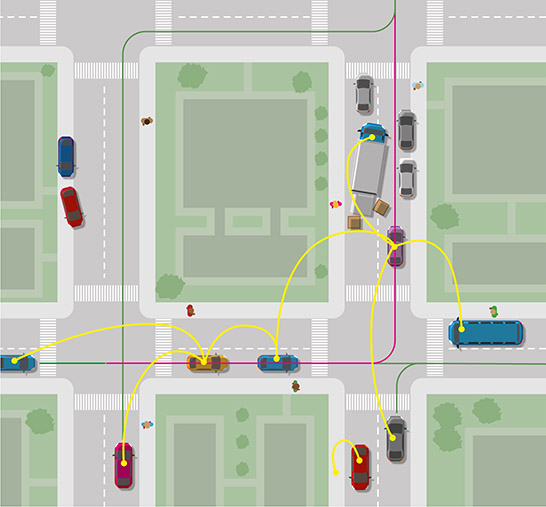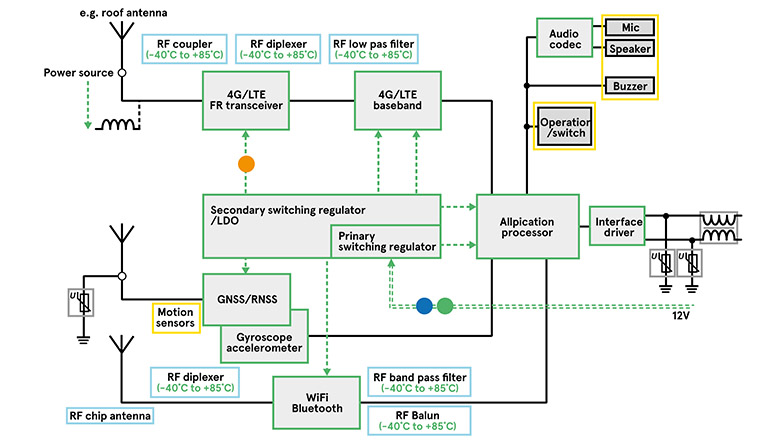Vehicle-to-vehicle (V2V) communication
For a long time, vehicles have been relatively insular – they have received radio signals for audio entertainment for decades, more recently, have become ‘connected’ to enhance functionality such as navigation and provide some streaming services. However, advanced communication is becoming central to vehicle operation as automakers see this as a way of delivering enhanced road safety, increased efficiency / economy and an improved experience for driver and passengers – eventually leading to fully autonomous vehicles.
As the sector is rapidly evolving, delivering these communication capabilities to vehicles presents a number of design challenges - negotiating the regulatory environment and selecting the optimum component solutions.
In fact, the vehicle communications sector is becoming so broad that it is often sub-divided into smaller sectors. The broadest is ‘vehicle to everything’ (V2X) which is generic for the whole sector while ‘vehicle to vehicle’ (V2V) and ‘vehicle to infrastructure’ (V2I) are the most common, and where the majority of development is taking place. Others are emerging including ‘vehicle to people’ (V2P) where vehicles and pedestrians will be able to have two-way communication.
In this article, we will primarily address the V2V sector, where all forms of road transport (cars, lorries, buses, vans and motorcycles among others) will be able to communicate directly with each other to share and collaborate on traffic conditions, road issues and other forms of hazards and delays.
V2V would be based around a peer-to-peer mesh network where each element of the network (a vehicle) is able to generate, receive and relay messages. With this approach, an expansive network can be created in populated areas without the need for expensive infrastructure. Typically, each vehicle would be able to transmit information about their speed, direction, location, braking and turning intent – although this list is likely to expand over time.
Alongside V2V will be V2I where the vehicle is able to interact bi-directionally with fixed infrastructure such as stop signals, road construction sites, train crossings and more.
V2V: an overview
| |
 Figure 1: V2V will be an integral part of V2X, delivering a far more intelligent environment on our roads Figure 1: V2V will be an integral part of V2X, delivering a far more intelligent environment on our roads
|
As automotive technology continues to move towards fully autonomous vehicles, V2V is expected to follow a similar evolutionary path. Initially, the systems will provide a warning to the driver of the vehicle, but once systems are more mature, they may be able to control the vehicle by braking or steering around obstacles.
Obstacle detection is one of the primary areas for vehicle vision systems and, although great advances have been made, there are limitations. For example, a vision system would struggle to detect a hazard such as a broken-down vehicle or queue of traffic around a bend, but a V2V implementation would not be constrained by line-of-sight and could reliably detect such situations. In reality, the inputs from vision systems and V2V are likely to be merged in ‘sensor fusion’ for confirmation and to eliminate false notifications.
V2V would form a mesh network and dedicated short-range communications (DSRC) is one technology being proposed by organisations such as the FCC and ISO. This is similar to WiFi, as it operates at 5.9GHz and has a range of approximately 300 metres – which equates to around 10 seconds on a highway. However, with up to 10 ‘hops’ on the mesh the ‘visibility’ of the V2V system extends to around a mile, which gives plenty of warning on busy roads where the mesh can extend this far.
Early implementations of V2V are likely to be a ‘warning only’ system where a visual indicator or audible warning (or both) are given to the driver. These will rapidly increase in sophistication and may indicate the direction and proximity of the issue as well as its nature. With systems such as automated emergency braking (AEB) becoming more prevalent, it won’t be long before vehicles are able to bring themselves to a safe halt based upon an alert from the V2V system.
The standards debate: and the challenge for designers
| |

Figure 2: V2V systems will form a mesh network, extending the range in congested areas |
With many emerging technology areas, there’s often a debate about technologies and standardisation – similar to the famous VHS / Betamax battle. In the case of V2V, the main debate is around the communications technology that will be used to form the mesh.
There are already some vehicles with V2V capability; one example is the 2017 Cadillac CTS sedan. This uses DSRC technology which comes as no surprise as this technology was prescribed by federal regulators in the US, and the FCC allocated 75MHz of bandwidth in the 5.9GHz band in 1999. Commercially, the Global Automakers trade association (which includes Honda, Nissan, Subaru, Kia and Toyota) is a supporter of DSRC. Pushing the point further, in 2016 the NHTSA began a process that would eventually mandate the inclusion of DSRC-based V2V technology for all cars sold in 2023 (and after).
However, DSRC isn’t the only option; 5GLTE cellular communication is another contender that has some strong advocates including Baidu in China who recently completed a test of 5GLTE-connected autonomous cars, and Volkswagen in Germany who stated that 5GLTE will connect all of their autonomous vehicles.
Those that advocate 5GLTE over DSRC cite various advantages including greater interoperability, wider bandwidth, increased security and the ability to use existing cell towers instead of dedicated roadside units. While the cell tower point is an issue on paper, it will only become ‘real’ once the dedicated roadside units have to be funded.
However, many powerful chipmakers that will develop the components that are essential for realising V2X/V2V are favouring cellular technologies such as C-V2X, with both Qualcomm and Ericsson stating they will develop solutions.
If only to illustrate the point that the future direction is far from certain, Autotalks is collaborating with CEVA to add C-V2X capability to their DSRC DSP chipsets allowing customers to toggle between the two standards.
The challenges for designers broadly fall into three key areas:
- Following the debate about communications standards and being ready with a design for the one that emerges as the forerunner, or for multiple standards if no clear choice emerges
- Developing a system that, within congested modern airwaves, can provide clear interruption-free communication to and from a vehicle that has a number of sources of significant interference including high current switching, inverters and Bluetooth / WiFi devices
- Providing safe and secure connectivity to integrate the V2V/V2X system into the rest of the increasingly complex vehicle systems
The critical role of passive components and connectivity
| |

Figure 3: Anatomy of a V2V system |
While semiconductor solutions will be integral to the communications standards battle, passive components including RF components such as antennas, EMC components, and transient protection devices will be required in the development of each and every V2V system, now and in the future.
One of the most fundamental components is the antenna. To assist designers, devices such as standard-off-the-shelf ceramic patch antennas are available that eliminate the design costs and cycle time associated with bespoke solutions. These high performance single-chip solutions are optimised for DSRC and offer proven high performance in a package measuring just 13mm x 13mm x 4mm.
Complete antenna solutions are also available, either optimised for the DSRC band or configured for multi-band (2.4GHz to 6GHz) operation. These are not generally PCB mounting but they include a suitable RF connector on a flying lead allowing remote placement of the antenna for optimum performance. With vehicle styling becoming increasingly important, ‘Pulse Shark Fin’ antennas are available that support multiple applications, thereby consolidating multiple system needs in a single stylish solution.
Summary
V2V promises to be an important development in its own right as well as forming an important building block for the fully autonomous vehicles of the future. With the inclusion of hundreds of sensors in modern vehicles, much of the information needed (speed, direction etc.) already exists and the final challenge is to develop the mesh networking infrastructure to allow vehicles to communicate with each other.
As standards evolve, decisions have to be made as to which communications standard will prevail in the long term and this forces designers to be agile with their solutions. Fortunately, many critical components such as antennas are available that will address multiple protocols, easing some of the pressure on design teams.
Below we’ve highlighted our leading suppliers for components suited to vehicle-to-vehicle (V2V) communication.
If you require advice on selecting the right components for your design, our technical specialists are on hand to help.
 Figure 1: V2V will be an integral part of V2X, delivering a far more intelligent environment on our roads
Figure 1: V2V will be an integral part of V2X, delivering a far more intelligent environment on our roads

